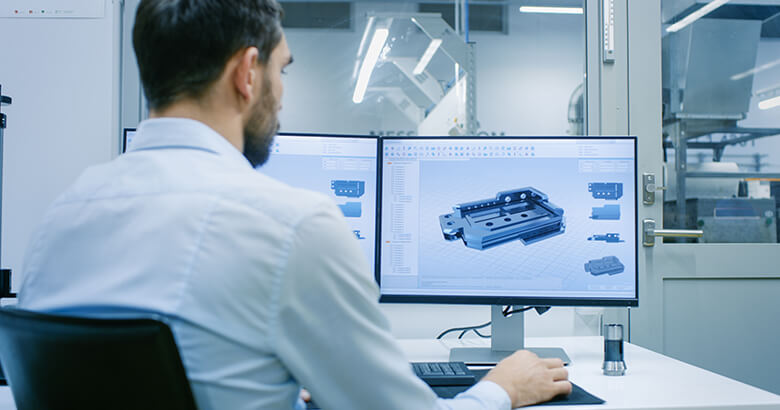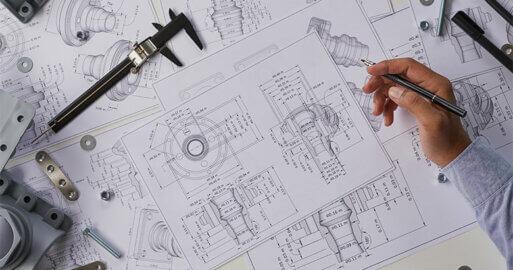Collaborative product development and data exchange in mechanical engineering and other technical industries

Globally operating companies with development and production sites distributed around the world as well as respective partner networks no longer limit their data exchange with customers and suppliers to pure CAD/CAx data, but add a wide range of product descriptions. There are a number of options for secure data exchange which we will describe in this article.
Engineering (CAD/CAx) and Product Data Exchange in the Entire Product Life Cycle
The development and construction of innovative and high-quality machinery is a complex process which uses software, electrics/electronics, mechanics and IT. Engineers work with a wide range of digital tools which entail an intensive exchange of engineering (CAD/CAx) and product data.
Whether in the project team, in the global partner network or with external engineering service providers, an intensive exchange of data increasingly dominates everyday work in these scenarios. In the manufacturing industries, such as mechanical and plant engineering or the automotive industry in particular, a whole range of engineering services is provided by external development service providers. Collaborative product development and design with OEMs, customers, partners and suppliers requires secure, integrated processes for engineering (CAD/CAx) and product data exchange.
Requirements for Continuous Integration and Secure Data Transfer
Due to digital transformation, the demand for integration of engineering partners and engineering data transfer has increased enormously. Areas to consider include: the security of the data transfer process in the DMZ, the data volume to be exchanged between the participants, the frequency of the data transfer processes, the number of exchange partners, the dynamics of the partner relationships and the variety of exchange scenarios such as online (synchronous)/offline (asynchronous).
Today, not only OEMs and suppliers to the automotive industry exchange engineering and product data, but also companies from all technically oriented industries, such as mechanical and plant engineering, process, aerospace, high-tech and electrical industries, white goods, shipbuilding and manufacturers of medical equipment. Almost all departments are involved in the data exchange process, such as development and design, research, engineering IT, IT data management, production, quality management, product management, maintenance and service as well as procurement, technical purchasing and PLM/PDM managers.
High Effort when Using Numerous OEM Engineering Portals
To utilise the Internet for electronic coordination with suppliers, engineering service providers and partners, OEMs and major first tier suppliers have created their own engineering portals. However, these cause considerable effort not only for the OEM as an operator, but also for the suppliers, engineering service providers and partners. Suppliers have to use numerous portals to transfer data. This increases the time and effort required by users for training and data maintenance. The short reaction times, e.g. for commenting on change requests, usually require frequent, sometimes recurring checking of the information. OEM portals are time-consuming and costly human-machine interfaces that require a lot of effort for monitoring and error-prone redundant data maintenance. With an increasing number of OEM portals, often covering numerous applications, suppliers, engineering service providers and other partners are looking for holistic, integrated solutions for engineering (CAD/CAx) and product data exchange.
Holistic, integrated data exchange as a decisive competitive factor in digitalization
Digitalization promises to optimize all business processes of a company. The big challenge here is not only the digitalization of individual business processes, but also the integration and networking of data and processes along the value chain in the entire product life cycle with all those involved. Each of these business processes has a decisive influence on costs and capital commitment and is therefore a decisive success factor for companies, especially in times of digital transformation and growing competition.
Get Ready with VDA ENGDAT/ENGPART and OFTP2 for International Data Exchange
In contrast to online connections, asynchronous data exchange involves the transmission of data in packets and not in transactions. In the automotive sector, the ENGDAT/ENGPART standard and the use of the ODETTE File Transfer Protocol 2 (OFTP2) has become established as the communication standard. Taking all the necessary security measures into account, the Internet is used as the transmission path.
While the Transport Layer Security (TLS) secures the entire session and the authentication, the information from the transmission is encrypted. The use of digital signatures provides proof that the data originates from the sender and has not been altered while on the move. With the end-to-end response as proof of receipt, the user receives the confirmation message. The maximum transferable file size is increased to 9.2 petabytes and the maximum length of the file name of 999 characters makes it possible to specify complete path names.
By avoiding the use of proprietary and industry-specific networks, costs are significantly reduced.
Managed File Transfer for Engineering Data through Portals
Numerous companies would like to operate the engineering data transfer via a portal-based solution, either on premises or in the cloud. In both cases, the solution must support the functions required for engineering data exchange. For example, a fully hosted solution can be used via the cloud, which can be used exclusively for the secure and reliable exchange of engineering (CAD/CAx) and product data. It is precisely this extension option of online data exchange that enables companies to connect 100% of their partners without having their own ENGDAT/OFTP system. Furthermore, these external partners can send files to the internal users of the company.
Essential features of such a solution are:
- Application with browser-based front end for the user
- Project-based work through directory sharing for other users (Share & Subscribe)
- Process for the ad-hoc data exchange (Up-/Download releases)
- Process for sending and receiving VDA ENGDAT messages via OFTP2/Internet
- Journal with overview of data transfer processes for ENGDAT/OFTP2 and download permit
- 2-way authentication with password sending via SMS
- User management to control user-dependent access rights and notification by email
- Simple onboarding of the partners
Integration Platform
Both the integration of IT environments and the seamless integration of data streams into the company’s own network can be achieved with the help of a central, end-to-end integration platform. The platform must support all methods of data exchange, including the common communication channels/protocols, and enable new developments such as API integration, API management, IoT and Industry 4.0.
SEEBURGER supports companies in the introduction of engineering (CAD/CAx) and product data exchange on the basis of the Business Integration Suite 6.7 and in partner onboarding.
Learn more about SEEBURGER solutions for integrated engineering (CAD/CAx) and product data exchange along the value chain.
Thank you for your message
We appreciate your interest in SEEBURGER
Get in contact with us:
Please enter details about your project in the message section so we can direct your inquiry to the right consultant.
Written by: Dr. Seref Erkayhan
Dr.-Ing. Seref Erkayhan is product manager for engineering (CAD/CAx) and product data exchange at SEEBURGER. He heads the division for mechanical and plant engineering.





